It’s Not That Simple
Can you picture yourself moving through a quiet lake on an early summer morning? The sun beginning to color the night away. Your arms are caught in a trance, moving forwards and back, perfectly tuned to the paddle in hand.
World-class athletes often mention how they feel as if their equipment is an extension of their bodies. This same dictum is repeated by experts in all fields. Kayaking is no different. Sadly, the vast majority of those that kayak don’t even know how deep this subject is.
There is so much more to paddle strokes and even your paddle blade than casuals realize. The worst part is, that casuals would benefit the most from learning how to properly perform a forward stroke.
The better your form, the less effort is required to move you along. You’ll have more power per movement and more energy to go further. Something worth learning.
The Truth about Your Paddle’s Size
What is strange about the world of kayaking, is that it completely goes against what most people believe. The bigger the better… we’ve all heard it a million times but the inverse is true when it comes to paddling.
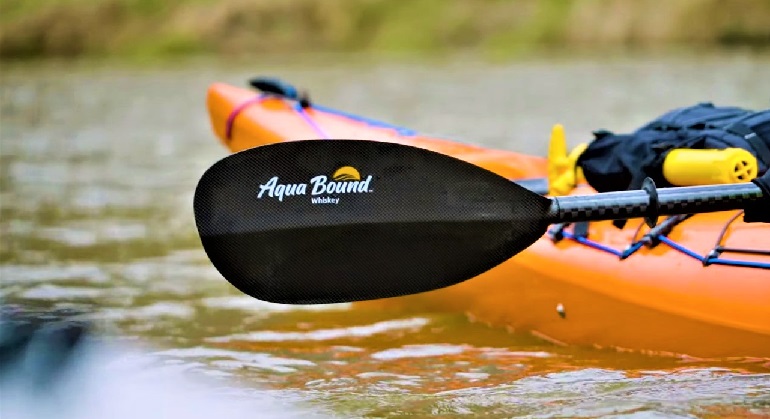
You’ll want to use as short a paddle as you comfortably can. How short will be determined by the width of your boat and the length of your upper body. Primarily, the length of your arms when outstretched.
Use a longer paddle blade and paddle when using a wide kayak. You’ll still want to stay on the shorter side of things.
However, those parameters are altered with the width of your vessel. It’s simple really. All you’ve got to do is sit within your kayak and keep sizing down until you can no longer comfortably paddle. Whatever size came before that point is the one for you.
Finding the right paddle for your size and kayak is important. It’ll be much more difficult to learn how to paddle a kayak with the wrong paddle size.
Knowing Your Paddle Shaft and Paddle Blade
The paddle blade and shaft are integral to learning the proper technique when it comes to holding our paddle. You need to hold your paddle properly. Failing to do so will result in you tiring yourself out long before you get anywhere.
It’s all about efficient power transmission. You want each of your kayak strokes to go as far as possible, with as little energy required. To achieve this goal, you’ll need to know the following things about your paddle and how you handle it.
Each part is integral for even the most basic strokes. The information only becomes more vital as you attempt higher-level maneuvering techniques.
Aligning Your Paddle Blades
How are your paddle blades positioned? Take a look at how the blades are positioned. If they are running parallel to one another, then you are all set. That was easy! However, if you notice that one blade is at an angle to the other. You should probably adjust them.
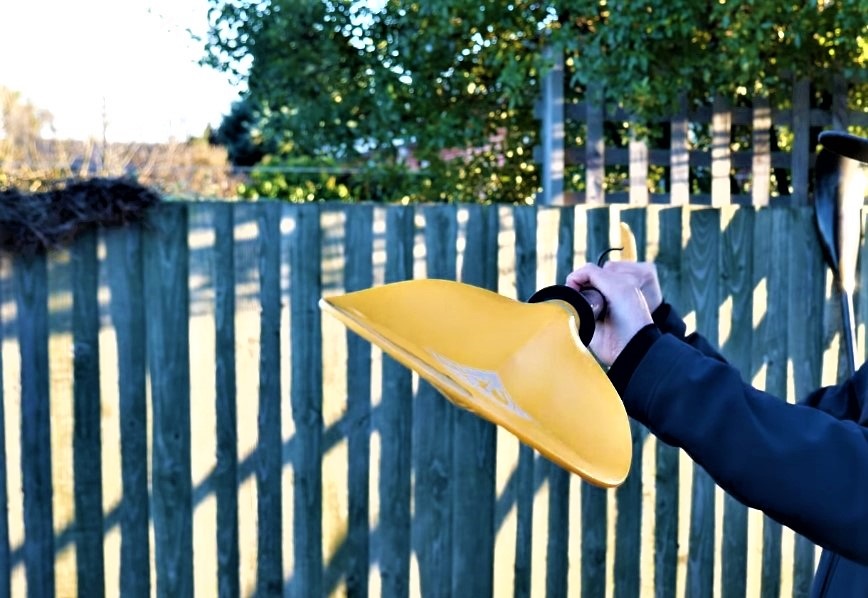
Could you learn proper stroke technique with your blades angled from one another? Sure, but it’ll be harder. What is the point of making things more difficult for yourself?
To adjust your blades, work through the paddle’s shaft. At its center, there should be a button. Press the button and rotate the two halves of your paddle until they are properly aligned.
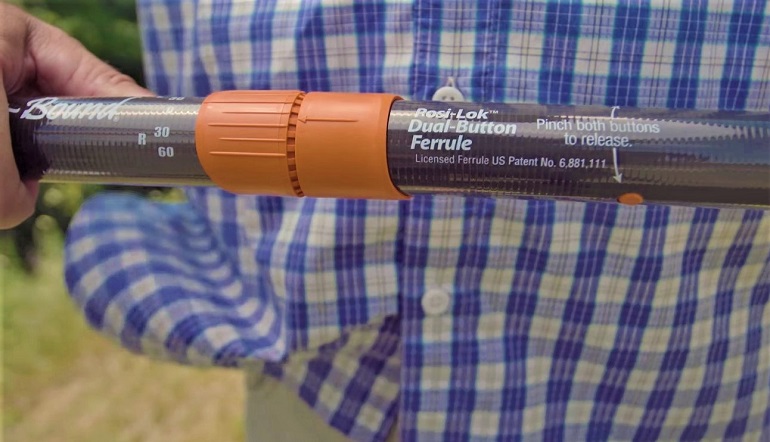
Now you’ll need to know whether you have symmetrical or asymmetrical blades. You won’t have to change your blade type. But you will need to know which type you have. An asymmetrical blade has one side shorter than the other side. Symmetrical blades are even all around.
The last thing you need to know about your blades is in which direction they are curved. Most kayak paddles have a curve in their blades. Using the proper side enables you to push more water sideways with each stroke.
Placing Your Paddle Blades in the Right Position
Hold your paddle out in front of you. Make sure that your knuckles are facing upward. Then ensure that the blades are running perpendicular to the ground.
If you have symmetrical blades, then don’t worry about this next step. When holding your paddle, you’ll want the smaller edge of your blade pointed downward.
As for the curve of your blade, it should be facing you. Again, this is not a concern if you have flat blades.
How You Should Be Holding the Paddle Shaft
As you paddle, you need to be able to rotate your torso correctly. This is important because it ensures that you have good power transmission. Place the paddle shaft’s center on your head.

You’ll want to move your hands until they are shoulder-width apart. Make sure that your elbows are at a ninety-degree angle. This is by far the most important factor.
As you begin to bring the paddle down, you’ll notice that the alignment of your arms, chest, and shaft itself has changed. This is the shape that you will want to maintain. This shape helps keep everything else in the right position.
The key to a killer forward sweep stroke, or even paddling in a straight line, is proper placement.
Proper Grip Technique
I’ll tell you how to properly grip the paddle but first, take a deep breath. If you are new to this, then no doubt, you are tense. You probably haven’t even realized it. Your knuckles are turning white, or perhaps your palms are sweaty.
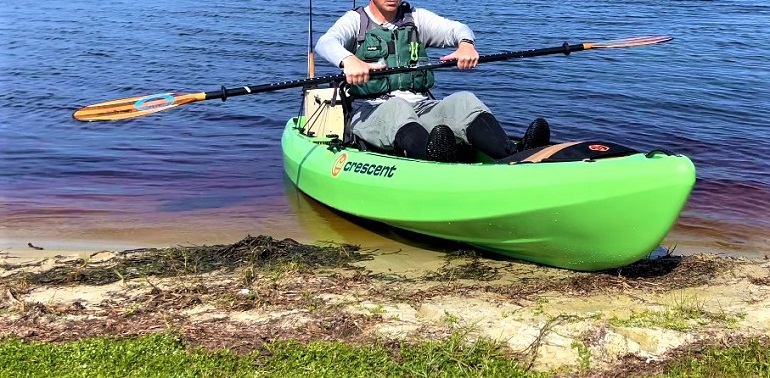
Relax your grip. A relaxed grip is absolutely integral to maintaining your energy. The tenser you are, the quicker you’ll become fatigued. The majority of your stroke technique should be powered by your upper body. Not your hands or arms.
The proper grip technique is to use your index finger and thumb to grip the shaft. Follow this up by letting the remaining fingers gently fall into place. A light hold at best. This is how you ensure that the right parts are doing the right amount of work.
The Anatomy of a Kayak Paddle Stroke
A paddle stroke really seems like a quick and simple movement. The truth is that there are several parts to it. By far, the easiest way to learn how to paddle a kayak is by breaking down a stroke technique into smaller parts.
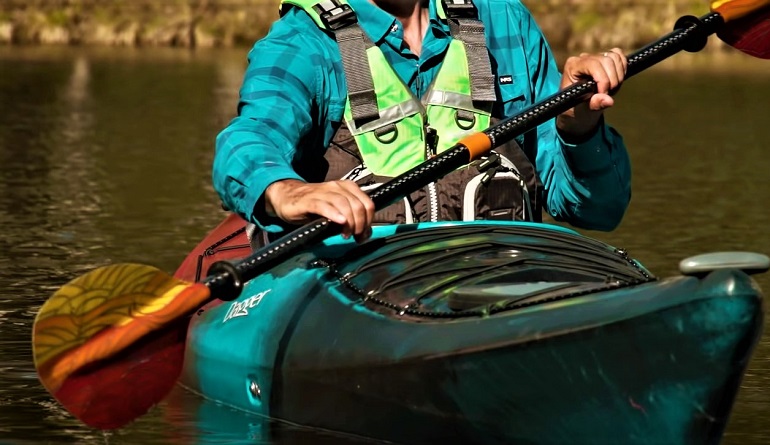
Below, I’ve taken a regular paddle stroke and simplified it into three key phases. Practice each phase until you’ve completely got it down. Then, move on to the next. The last step will be to complete each phase in succession.
Only then will you have a proper kayak paddle stroke down, and you’ll be able to move on to the more advanced kayak paddling techniques.
Winding up with the Starting Direction
This step is one hundred percent centered around your body position as you progress through a stroke. Your upper body should wind up in the initial starting direction of the stroke.
Your arms will each have their own position and placement. Your upper arm, on the paddle, will have to be slightly bent, the same as your wrist, when near your face. As for your lower arm, it’ll be much easier to handle.
All you need to do is maintain your lower arm mostly straight. Not completely straight, but nearly all the way there. It sounds like a lot to handle at the moment, but the more you practice, the better you’ll get at it.
In reality, all you have to worry about is placing everything where it needs to be. The rest handles itself.
Catching the Water
This phase is all about the moment the blade of your paddle enters the water. With your blade immersed in the water, begin to unwind your torso. This step is difficult because you have to make sure not to unwind with your arms.
This process of pulling the blade through the water should only be pushed forward by your chest. You are going to have to engage those core muscles to get it right. You’ll know that you are doing it right because your abs will be on fire.
Literally, they’ll be burning but hey, at least you did it right.
Recovery
This is more of a result of your previous two actions than an action all on its own. Once you are caught in the rhythm of your movements, your elbows will naturally move in the direction required. That is if you followed through on the previous two steps.
While one elbow moves down, the other is winding up to start the process all over again. Once you finally work out any annoying kinks, you’ll be able to seamlessly transition from one stroke to the next. Each one helps the next one along.
This is why you end up saving more energy using the proper technique. Momentum is everything.
Proper Paddling Techniques for Moving Water
We’ve got the basics out of the way. With your paddle properly adjusted and the right form memorized, you are ready for the next steps. You should think of the following strokes as tools to add to your arsenal.
Pull any of them out when the situation calls for it. Each type of stroke engages different muscles and has its own best use-case scenario. Keep in mind that you will need to practice each one with as much dedication as you did the regular stroke.
The end result is always worth it. Feeling completely in control of your kayak is an amazing thing.
The Forward Stroke
The forward stroke will be the stroke that you use the most. Once you reach a high enough skill level, it’ll become your autopilot mode. To do this stroke, you’ll need to first sit up straight.
Then you need to place your blade in the water, near the bow of your kayak. Pull the paddle toward you, engaging your core muscles in the process. Push in the direction opposite the shaft.
Bring the blade up once it is near your hip. As you sink the other blade into the water, rotate your body. Repeat these steps until you get to where you wanna be.
Changing Course with the Reverse Stroke
This stroke helps when you want to change course completely or do a simple turn with your kayak. Place your blade as far forward as you can go. Near your toes. Drop one blade into the water and then sweep it in one big arc.
This movement has to be a wide arc that curves but then returns to a position aligned with where you started. Remember to keep your arms straight and engage your core. Keep the pulling motion going until the blade reaches the stern of your kayak.
Bring this end out of the water to complete one cycle. Repeat as needed.
Going in Reverse with the Sweep Stroke
You can’t keep moving forward forever, eventually, the water runs out. For when you’ve reached the end of the line, the sweep stroke will help you go in reverse.
To start this stroke off, you’ll need to dip one paddle blade into the water near the stern of your kayak. Wind your body up in the same direction. Now pull the paddle toward the front but make sure that it runs along the kayak’s side.
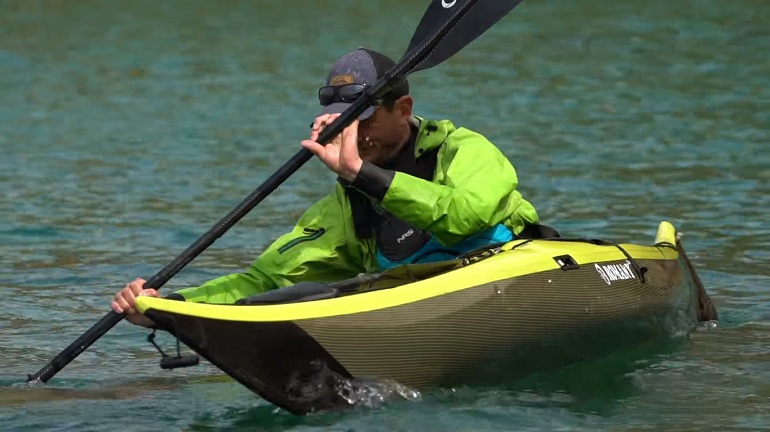
Once it reaches the front of the kayak, bring the blade out of the water and repeat the entire process again with the other side.
The Draw Stroke
Oddly enough, you can move your kayak sideways should you want to. It sounds strange because, in a world dominated by cars and trains, this is a direction that we often forget about. To move your kayak sideways, you’ll need to get the paddle’s blade into a horizontal position.
Turn your upper body in the direction that you want to go in. Dip the blade into the water but a couple of feet away from your kayak. Begin to pull the paddle in, as if you were trying to get the kayak and blade to meet each other.
Keep reeling it in but stop short of hitting the side of your kayak. Drag the blade out of the water and repeat the entire process.
The Sculling Stroke
Alright, we’ve gone forward and backward. We now know how to change direction and even how to paddle sideways. What’s next? Learning how to fly? Not quite, the sculling stroke is the final stroke that we will be going over.
Think of this stroke as the way that experts kayak sideways.
To perform this stroke, you need to get your paddle into a vertical position. You’ll know that you got it right when one blade is in the water, and your upper arm is high in the air. Make sure that your upper arm is bent at a ninety-degree angle.
Start paddling in a back-and-forth motion albeit, in a short path. Wind your body toward the direction you want to go in and continue this process. Eventually, you’ll start moving sideways. Sounds simple. It isn’t.
Some Advice for Practicing Basic Kayak Paddling Techniques
Even if you follow every step outlined above, to the letter, mistakes will be made. This isn’t a knock on your abilities or anything, it’s just the way things are. The best way to figure out where you are failing is to have someone keep an eye on you.
A friend or instructor will have a fresh set of eyes that will serve you well. They’ll be able to realize the mistakes you are making way faster than you can.
However, if for whatever reason, this isn’t an option, there is another way. I would recommend that you record yourself as you kayak. This close-up view of the action can be rewound endlessly to help you figure out any missteps.
My Final Thoughts
We’ve made it to the end. Please don’t tell me that everything we’ve gone through has scared you off from kayaking. Believe me, even if you already enjoyed kayaking before, you’ll grow to love it once it becomes less of a tedious and demanding activity.
When kayaking, the water below should be the challenge, not your stroke. Be sure to keep in mind that placement and posture are everything. They ensure that you expend as little energy as possible.
If you continue to work at it, you’ll be doing a reverse sweep stroke in no time. Honestly, these names just keep getting longer and longer.
0 Comments